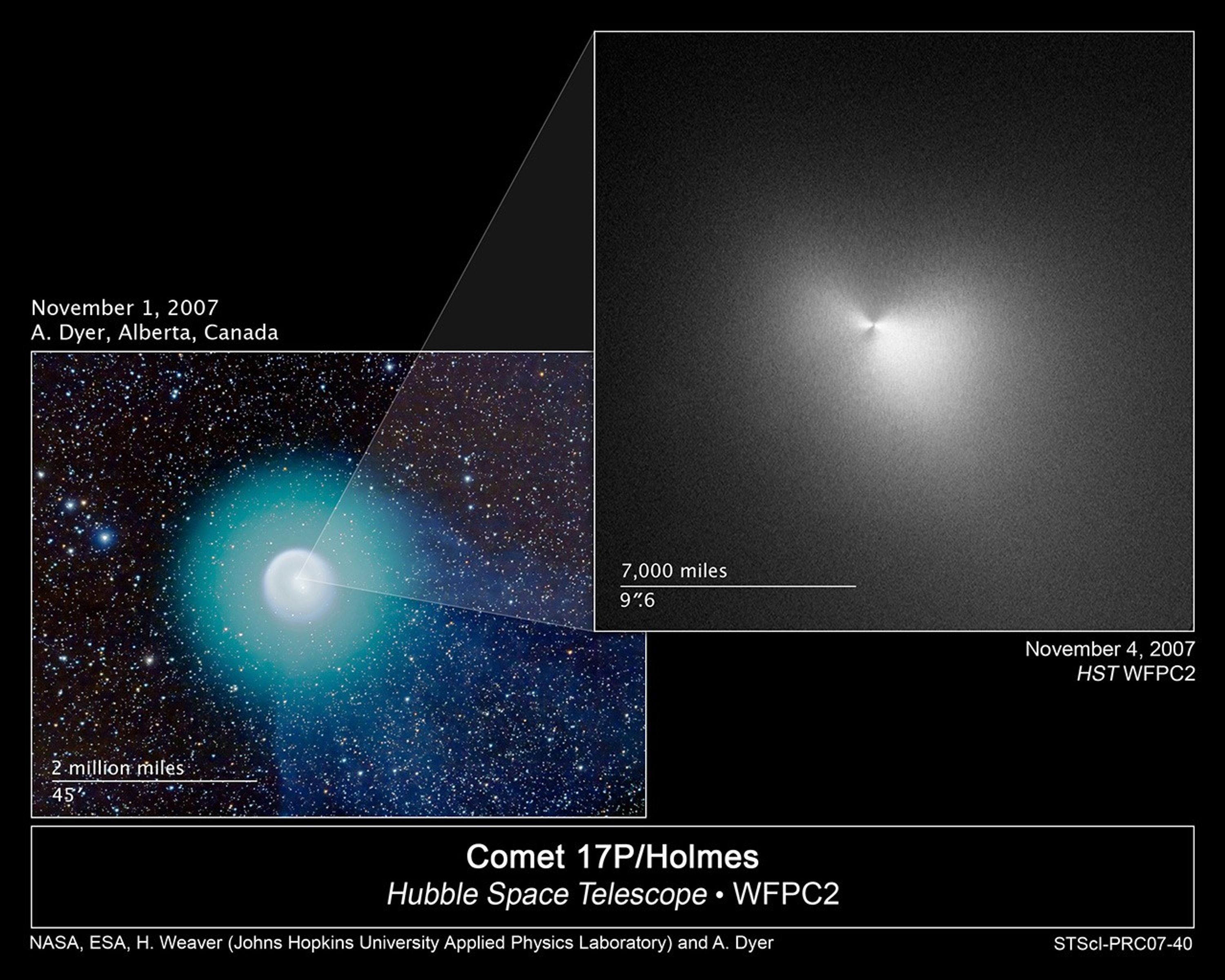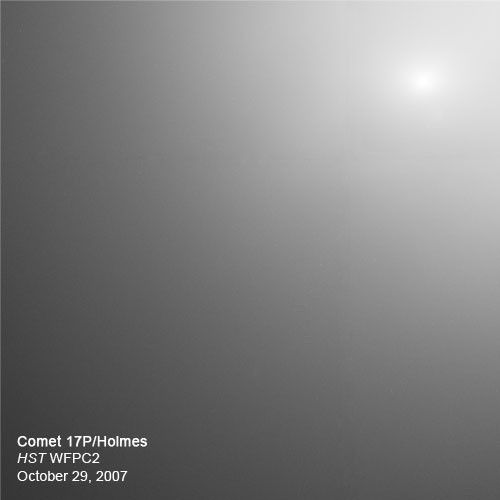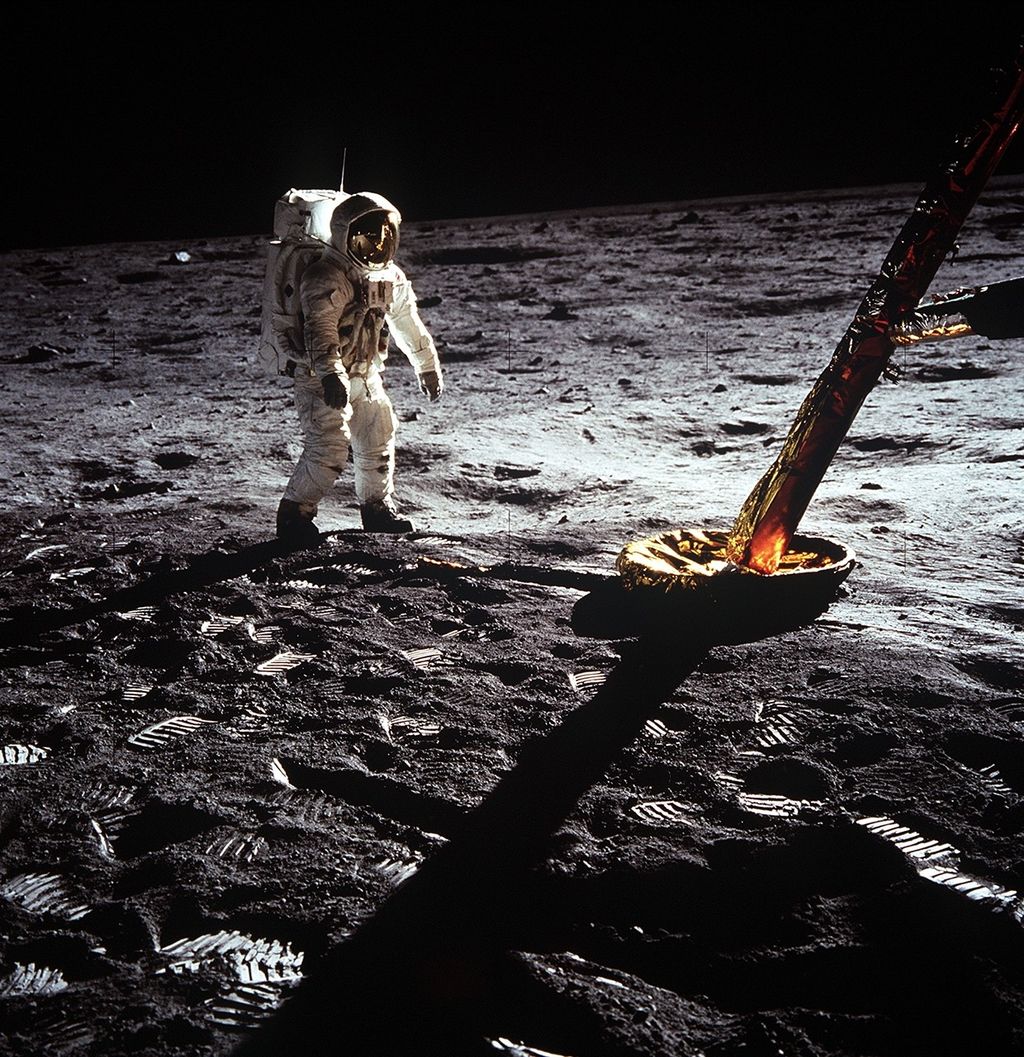1 min read
Hubble Zooms In on Heart of Mystery Comet

NASA's Hubble Space Telescope has probed the bright core of Comet 17P/Holmes, which, to the delight of sky watchers, mysteriously brightened by nearly a millionfold in a 24-hour period beginning Oct. 23, 2007.
Astronomers used Hubble's powerful resolution to study Comet Holmes' core for clues about how the comet brightened. The orbiting observatory's Wide Field Planetary Camera 2 (WFPC2) monitored the comet for several days, snapping images on Oct. 29, Oct. 31, and Nov. 4. Hubble's crisp "eye" can see objects as small as 33 miles (54 kilometers) across, providing the sharpest view yet of the source of the spectacular brightening.
The Hubble image at right, taken Nov. 4, shows the heart of the comet. The central portion of the image has been specially processed to highlight variations in the dust distribution near the nucleus. About twice as much dust lies along the east-west direction (the horizontal direction) as along the north-south direction (the vertical direction), giving the comet a "bow tie" appearance.
The composite color image at left, taken Nov. 1 by an amateur astronomer, shows the complex structure of the entire coma, consisting of concentric shells of dust and a faint tail emanating from the comet's right side.
The nucleus - the small solid body that is the ultimate source of all the comet's activity - is still swaddled in bright dust, even 12 days after the spectacular outburst. "Most of what Hubble sees is sunlight scattered from microscopic particles," explained Hal Weaver of The Johns Hopkins University Applied Physics Laboratory in Laurel, Md., who led the Hubble investigation. "But we may finally be starting to detect the emergence of the nucleus itself in this final Hubble image."
Hubble first observed Comet 17P/Holmes on June 15, 1999, when there was virtually no dusty shroud around the nucleus. Although Hubble cannot resolve the nucleus, astronomers inferred its size by measuring its brightness. Astronomers deduced that the nucleus' diameter was approximately 2.1 miles (3.4 kilometers), about the length of New York City's Central Park. They hope to use the new Hubble images to determine the size of the comet's nucleus to see how much of it was blasted away during the outburst.
Hubble's two earlier snapshots of Comet Holmes also showed some interesting features. On Oct. 29, the telescope spied three "spurs" of dust emanating from the nucleus, while the Hubble images taken on Oct. 31 revealed an outburst of dust just west of the nucleus.
The Hubble images, however, do not show any large fragments near the nucleus of Comet Holmes, unlike the case of Comet 73P/Schwassmann-Wachmann 3 (SW3). In the spring of 2006 Hubble observations revealed a multitude of "mini-comets" ejected by SW3 after the comet increased dramatically in brightness.
Ground-based images of Comet Holmes show a large, spherically symmetrical cloud of dust that is offset from the nucleus, suggesting that a large fragment broke off and subsequently disintegrated into tiny dust particles after moving away from the main nucleus.
Unfortunately, the huge amount of dust near the comet's nucleus and the comet's relatively large distance from Earth (149 million miles, or 1.6 astronomical units, for Holmes versus 9 million, or 0.1 astronomical unit, for SW3) make detecting fragments near Holmes nearly impossible right now, unless the fragments are nearly as large as the nucleus itself.
The Hubble Comet Holmes observing team comprises H. Weaver and C. Lisse (The Johns Hopkins University Applied Physics Laboratory); P. Lamy (Laboratoire d'Astrophysique de Marseille, France); I. Toth (Konkoly Observatory, Hungary); M. Mutchler (Space Telescope Science Institute); W. Reach (California Institute of Technology); and J. Vaubaillon (California Institute of Technology).
About the Object
- R.A. PositionR.A. PositionRight ascension – analogous to longitude – is one component of an object's position.03h 42m
- Dec. PositionDec. PositionDeclination – analogous to latitude – is one component of an object's position.+50° 37'
- ConstellationConstellationOne of 88 recognized regions of the celestial sphere in which the object appears.Perseus
- DistanceDistanceThe physical distance from Earth to the astronomical object. Distances within our solar system are usually measured in Astronomical Units (AU). Distances between stars are usually measured in light-years. Interstellar distances can also be measured in parsecs.On November 4, 2007, Comet 17P/Holmes was 1.62 Astronomical Units from the Earth, and 2.48 Astronomical Units from the Sun.
- DimensionsDimensionsThe physical size of the object or the apparent angle it subtends on the sky.Comet 17P/Holmes has the following orbital values: Aphelion distance: 5.2 Astronomical Units; Perihelion distance: 2.1 Astronomical Units; Semi-major axis: 3.6 Astronomical Units
About the Data
- Data DescriptionData DescriptionProposal: A description of the observations, their scientific justification, and the links to the data available in the science archive.
Science Team: The astronomers who planned the observations and analyzed the data. "PI" refers to the Principal Investigator.Ground Based Image (left): The ground-based image of Comet 17P/Holmes was taken November 1, 2007, by astrophotographer Alan Dyer. The observations were made in southern Alberta, Canada with a 105mm apochromatic refractor at f/5 with a Canon 20Da camera at ISO400. Field is about 2.5 x 1.5 degrees. Hubble Image (right): The Hubble image was created from HST data from proposal 11418: H. Weaver (Johns Hopkins University/Applied Physics Laboratory), C. Lisse (University of Maryland), P. Lamy (Space Astronomy Laboratory, Marseille), I. Toth (Hungarian Academy of Sciences), W. Reach and J. Vaubaillon (California Institute of Technology), and M. Mutchler (STScI). - InstrumentInstrumentThe science instrument used to produce the data.HST>WFPC2 (right)
- Exposure DatesExposure DatesThe date(s) that the telescope made its observations and the total exposure time.November 1, 2007 (left) and November 4, 2007 (right)
- FiltersFiltersThe camera filters that were used in the science observations.WFPC2: F555W (V) and F675W (R)
- Object NameObject NameA name or catalog number that astronomers use to identify an astronomical object.Comet 17P/Holmes
- Object DescriptionObject DescriptionThe type of astronomical object.Periodic Comet in our Solar System
- Release DateNovember 15, 2007
- Science ReleaseHubble Zooms In on Heart of Mystery Comet
- Credit

Related Images & Videos

Ground-based Image of Comet Holmes - November 1, 2007
The ground-based image of Comet 17P/Holmes was taken November 1, 2007, by astrophotographer Alan Dyer. The observations were made in southern Alberta, Canada with a 105mm apochromatic refractor at f/5 with a Canon 20Da camera at ISO400. Field is about 2.5 x 1.5 degrees.

Comet 17P/Holmes Hubble Image Series
These images taken by NASA's Hubble Space Telescope reveal Comet Holmes's bright core. The images show that the coma, the cloud of dust and gas encircling the comet, is getting fainter over time. The coma was brightest in the Oct. 29 image. It is two times fainter on Oct. 31 and...

Animation of Comet 17P/Holmes Dimming Over Time
This animation is a composite of images taken by NASA's Hubble Space Telescope that reveal Comet Holmes's bright core. The images show that the coma, the cloud of dust and gas encircling the comet, is getting fainter over time. The coma was brightest in the Oct. 29 image. It is...
Share
Details
Claire Andreoli
NASA’s Goddard Space Flight Center
Greenbelt, Maryland
claire.andreoli@nasa.gov


































